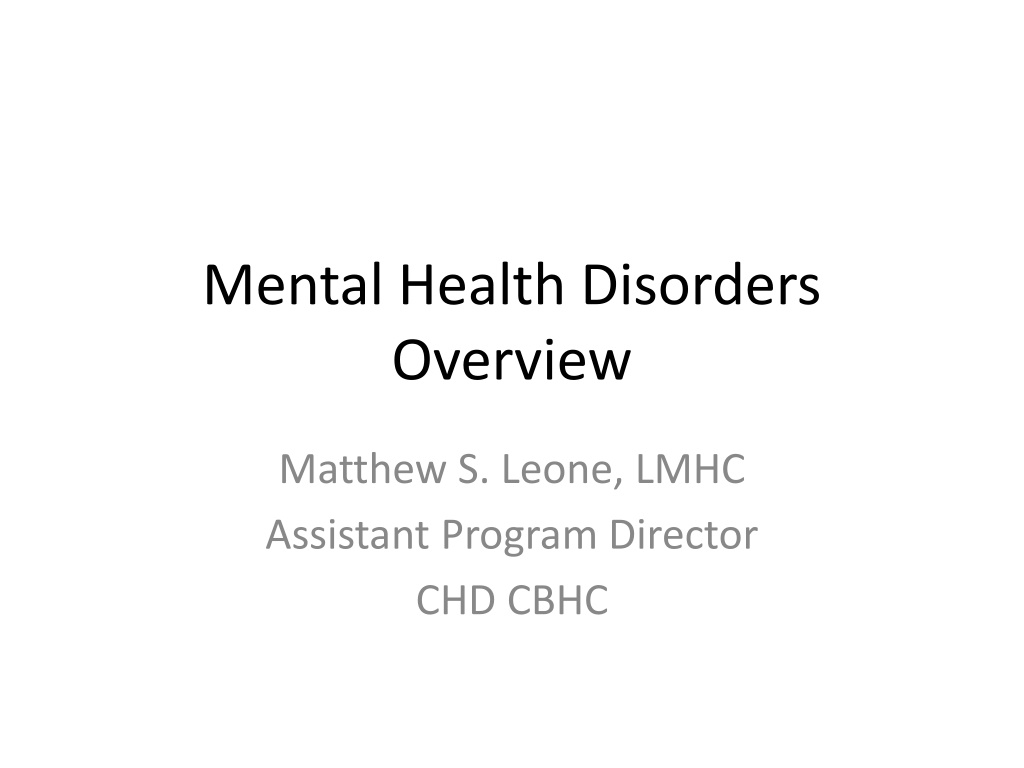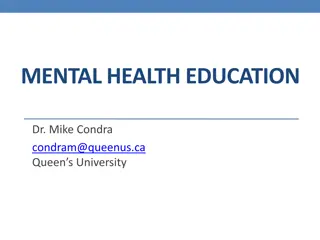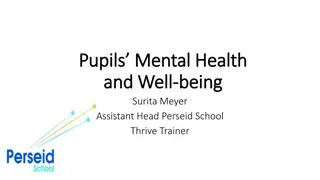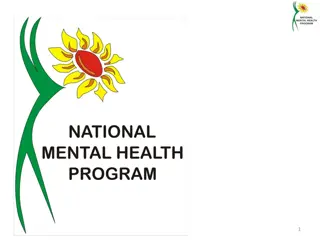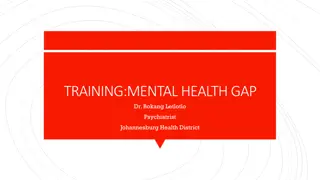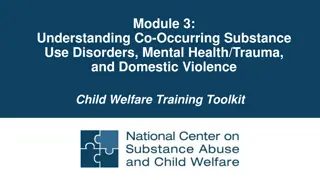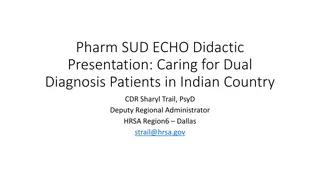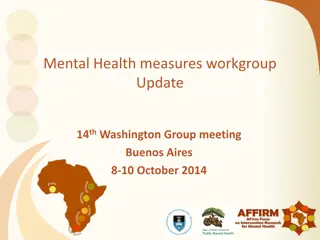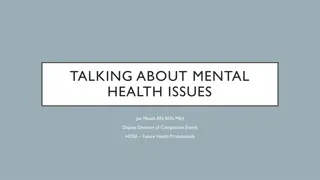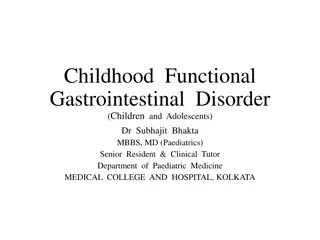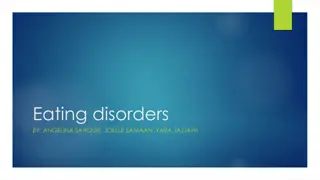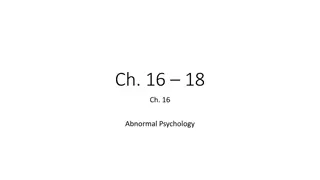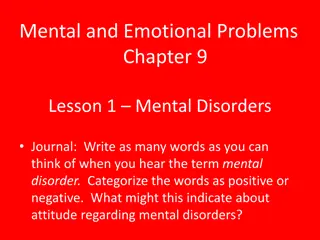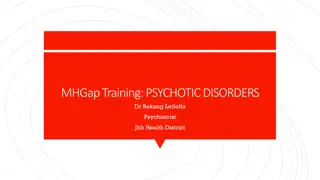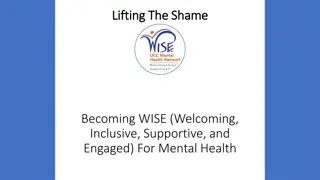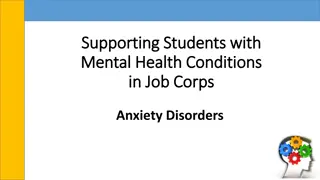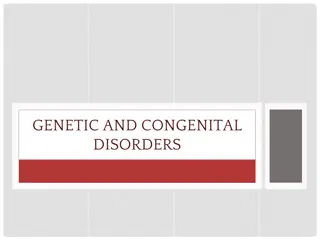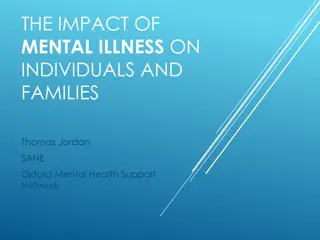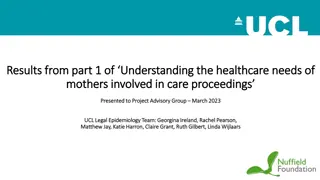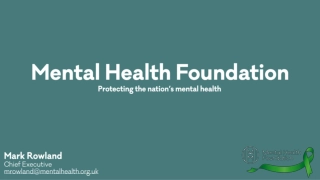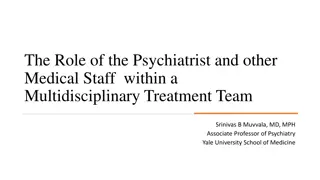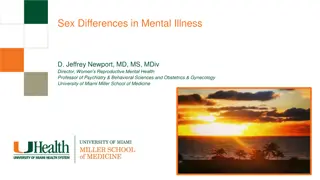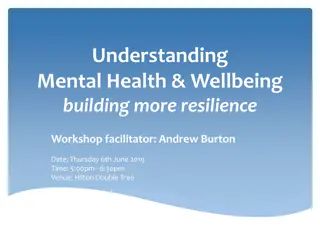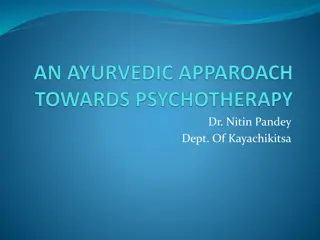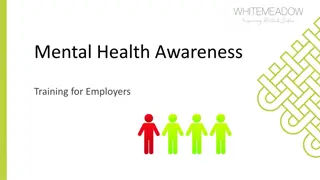Understanding Mental Health Disorders and Their Impact
Mental health disorders are prevalent, affecting 1 in 5 adults in the U.S. each year. They can significantly impair various aspects of life and lead to severe consequences, including high costs, hospitalizations, homelessness, and incarceration. Factors contributing to mental illness vary from biological and social/environmental to psychological factors. Types of mental disorders include mood, anxiety, psychotic, personality, substance use, stress, trauma-related, and dissociative disorders.
Download Presentation

Please find below an Image/Link to download the presentation.
The content on the website is provided AS IS for your information and personal use only. It may not be sold, licensed, or shared on other websites without obtaining consent from the author. Download presentation by click this link. If you encounter any issues during the download, it is possible that the publisher has removed the file from their server.
E N D
Presentation Transcript
Mental Health Disorders Overview Matthew S. Leone, LMHC Assistant Program Director CHD CBHC
Overview Approximately 1 in 5 adults in the U.S. (43.8 million, or 18.5%) experiences mental illness in a given year. 90% of those who die by suicide have an underlying mental illness. Mental Illness results in more disability than: Cancer Diabetes Heart Disease
Consequences & Costs of Mental Illness $193.2 billion in lost earnings per year. Mood disorders are the 3rdmost common cause of hospitalization for ages 18 to 44. 26 % of homeless adults in shelters have a MI 24% of prisoners have a history of a MI
What is Mental Illness? Substantial disorder of Thought Mood Perception Memory Can significantly impair judgment, behavior, capacity to recognize reality, or ability to meet the ordinary demands of life
Types of Mental Illness Mood Disorders Depressive Disorders, Bipolar Disorder Anxiety Disorders Psychotic Disorders Personality Disorders Substance Use Disorders Stress & Trauma-Related Disorders Dissociative Disorders Dissociative Disorders
Biological Factors Biochemical Disturbances Genetics Infections- can cause brain damage Brain defects or injury Prenatal damage Poor nutrition, exposure to toxins
Social/Environmental Factors Significant life events: Death, divorce, changing jobs/school Significant local/world events Disasters A dysfunctional family life, including domestic violence Living in an unsafe environment Living in poverty Feelings of inadequacy, low self-esteem, or loneliness Social or cultural expectations Substance abuse
Psychological Factors Severe psychological childhood trauma, such as emotional, physical or sexual abuse An important early loss, such as the loss of a parent Neglect Poor ability to relate to others
What is severe, persistent mental illness (SPMI) ??? Complex symptoms Often requires ongoing treatment and management. Most often requires varying types and dosages of medication, therapy, and support. Can vary in intensity and acuity.
The Good News? Mental illness is treatable and people can recover.
The not so good news?? Nearly 60% of adults with a MI do not receive treatment Nearly 50% of youth (8yrs to 15 yrs.) do not receive treatment African American and Hispanic Americans used mental health services at about one-half the rate of whites.
The single most common barrier to seeking treatment? Shame and Stigma
Anxiety Disorders Occasional anxiety and worry are a normal part of life. Anxiety disorders involve more than temporary worry or fear. The anxiety does not go away, can get worse over time, and can interfere with daily activities. Most anxiety disorders begin in childhood, adolescence and early adulthood.
Anxiety Disorders Panic Disorder Obsessive Compulsive Disorder * Post Traumatic Stress Disorder Social Anxiety Disorder Specific Phobias Generalized Anxiety Disorder
Symptoms of Anxiety Disorders Feelings of panic, fear and uneasiness Uncontrollable, obsessive thoughts Repeated thoughts or flashbacks of traumatic experiences Nightmares Ritualistic behaviors, such as repeated hand washing Problems sleeping Cold or sweaty hands Shortness of breath Palpitations An inability to be still and calm Dry mouth Numbness or tingling in the hands or feet Nausea Muscle tension
Anxiety Disorders: Why someone may call 911 Experiencing panic attack symptoms Extreme worry Child won t go to school Feel like they are going crazy
Communication & Response Encourage slow ,deep breaths If this is difficult for the individual, ask him to do it with you Reassure Speak slowly & calmly
Types of Depression Situational/Adjustment Bereavement Seasonal Dysthymia Post-Partum Depression Bipolar depression Clinical Depression Psychotic Depression
Clinical Depression An illness, not a weakness Serious disturbances in work, social, and physical functioning including suicidal thought Not relieved by circumstances May last for months or years untreated Persistent and intense mood change
Clinical Depression: Signs & Symptoms Extreme sadness, guilt, shame Decreased memory and concentration, poor academic performance or work performance Decreased interest/enjoyment in daily activities Increased irritability, arguments Change in sleep, appetite, energy Physical unease Social withdrawal Hopelessness, helplessness Suicidal thoughts
Depressive Disorders: Why someone may call 911 Suicidal thoughts Hopelessness Family, friends, providers may call for wellbeing check
Bipolar Disorder Also known as manic depression. A disorder that causes unusual shifts in mood, energy, activity levels, and the ability to carry out day-to-day tasks. Episodic extremes between states depressed state and excitable, euphoric/irritable, impulsive state
Symptoms of Bipolar Disorder Symptoms of mania ("the highs"): Excessive happiness, hopefulness, and excitement Sudden changes from being joyful to being irritable, angry, and hostile Restlessness Rapid speech and poor concentration Increased energy and less need for sleep High sex drive Tendency to make grand and unattainable plans Tendency to show poor judgment, such as deciding to quit a job Drug and alcohol abuse Increased impulsivity Can become psychotic
Bipolar Disorder: Why someone may call 911 Manic symptoms Grandiosity Placing self in unsafe situations Missing Person
Personality Disorders People with personality disorders have extreme and inflexible personality traits that are often distressing to the person and/or cause problems in work, school or social relationships. The patterns of thinking and behavior significantly differ from the expectations of society and are so rigid that they interfere with the person's normal functioning. Examples include: antisocial personality disorder, obsessive-compulsive personality disorder, paranoid personality disorder, and borderline personality disorder.
Personality Disorders: Why someone may call 911 Suicidality Anger, aggression Connection Relationship issues
Schizophrenia Spectrum and Other Psychotic Disorders Schizophrenia Schizoaffective Disorder Delusional Disorder Schizotypal (Personality) Brief Psychotic Disorder Schizophreniform Disorder Substance/Medication-Induced Psychotic Disorder Psychotic Disorder Due to Another Medical Condition
Schizophrenia Schizophrenia is a chronic and severe mental disorder that affects how a person thinks, feels, and behaves. People with schizophrenia may seem like they have lost touch with reality, often experiencing delusions and hallucinations. Symptoms lasts longer than six months, often with a decline in work, school and social functioning.
Positive Symptoms Positive symptoms are psychotic behaviors not generally seen in healthy people. may lose touch with some aspects of reality. Hallucinations Delusions Thought disorders (unusual or dysfunctional ways of thinking) Disorganized or incoherent speech Movement disorders (agitated body movements)
Hallucinations and Delusions Hallucinations are unusual sensory experiences or perceptions of things that aren't actually present, Can involve all five senses. Delusions are false beliefs that are persistent and organized, and that do not go away after receiving logical or accurate information.
Negative Symptoms Negative symptoms are associated with disruptions to normal emotions and behaviors. Flat affect (reduced expression of emotions via facial expression or voice tone) Reduced feelings of pleasure in everyday life Slowed or unusual movements Difficulty beginning and sustaining activities Reduced speaking
Cognitive Symptoms The cognitive symptoms of schizophrenia can be subtle or more severe. Symptoms include: Poor executive functioning (the ability to understand information and use it to make decisions) Trouble focusing or paying attention Problems with working memory (the ability to use information immediately after learning it)
Psychotic Disorders: Why someone may call 911 May call due to reality disturbance Paranoia Concern from family, friends, providers, etc. Danger to self or others Not caring for self
Psychosis The 3 possible responses to a person who loses contact with reality, and are either hallucinating or delusional, are: A. Agree with them B. Dispute them, or C. Defer the issue Which is the appropriate response: A, B or C?
Delusions Convey your acceptance but let the individual know that you are not experiencing it and reinforce reality. I can hear that you are scared that someone is out to get you, but I don t know of anyone who is trying to hurt you . . . I m here to help you and keep you safe. Don t argue about the delusion no one will win this argument
Are childhod disorders diferent from adult disorders? Many diagnoses are the same across the lifespan, but the symptoms can appear different at different ages. Some diagnoses are pretty commonly made in childhood/adolescence rather than in adults. Primary examples: ADHD, Oppositional Defiant Disorder, Conduct Disorder, Disruptive Mood Dysregulation Disorder.
How are Childhood Disorders Diagnosed? Through observation Through reports from adults involved with the child Accurate diagnosis should involve input from multiple sources of observation/information. Childhood diagnoses are particularly subject to change and re-evaluation over time due to the child s development
Police might see kids with ADHD when: When they run out of school, or away from home They act out in school or at home, and become physically aggressive or destructive of property They are involved in impulsive crimes, like shoplifting they may tend to be followers rather than leaders
Thats because Problems with attention, focus and follow- though Poor planning skills not anticipating consequences Low frustration tolerance Social difficulties speaking or acting without thinking can alienate their peers
Untreated, ADHD/ADD is correlated with Lower levels of educational achievement Lower job satisfaction Higher rates of substance use disorders, Disruptions in family life, Higher levels of incarceration
Keep in Mind - ADHD and ADD are highly heritable disorders, 30% of men who have ADHD will have at least one child with ADHD. This makes behavior management challenging for these parents
Police might see kids with Oppositional Defiant Disorder/Conduct Disorder when: They are picked up for minor infractions such as curfew violations, or more serious actions such as breaking and entering, selling and/or receiving stolen goods, drug use, physical aggression or property destruction, They violate a CRA or probation agreement 50-60% of youth in the juvenile justice system have some type of behavioral health diagnosis or mental illness
Thats because - Youth with these disorders are chronically defiant and resistant to direction They naturally come into conflict with all types of authority figures. They are also planners, rather than acting on impulse, so they may be engaged in more high-stakes behavior Their school/home discipline issues often spill over into aggression
Commonly treated with: Medications to lessen any level of impulse disorder that may be complicating the picture Other medications to help with controlling aggressive outbursts or mood swings But their behavior issues often lead to the legal system
Keep in mind - Behaviors may appear purely oppositional but may really be a response to Chaotic or unstable home environments, trauma, or other undiagnosed disorders Kids may be communicating something with their behavior that they do not have the verbal skills or trust level to communicate in other ways
Police might see youth with Mood Disorders (Depression, Anxiety disorders, Bipolar disorder) when: They exhibit self-destructive or aggressive behavior, in the home or at school Parents become concerned over statements they make threatening harm towards themselves or towards others They are involved in conflicts in the community with peers or authority figures
Youth with mood disorders are at high risk for suicide attempts and for self-injurious behavior. Suicide is the 3rd leading cause of death for youth 10-14 and the 2nd for youth 15-34 They may engage in cutting, or develop eating disorders, and there are online communities that promote this behavior and normalize it for affected teens
Teens with these disorders are also highly vulnerable to predators, especially if they do not have a supportive social network in place and especially online, where most parents will be unaware of their child s activities
Thats because Adolescents are developmentally programmed to seek out peer approval They naturally want to belong with peers rather than with adults This means that if they are not able to feel comfortable with a naturally occurring peer group they will find a peer group elsewhere, whether online or elsewhere
